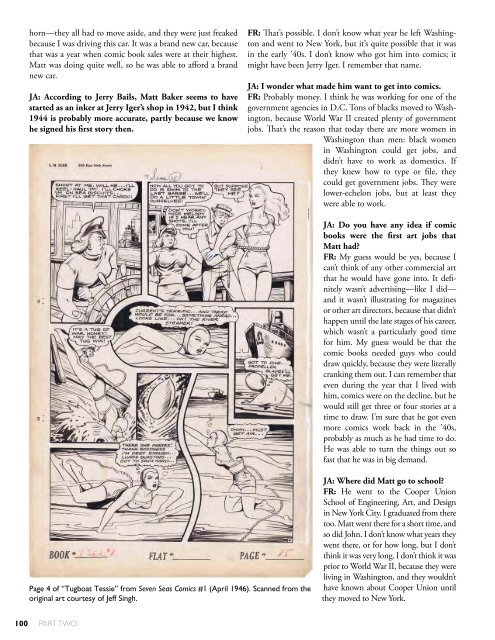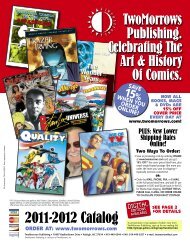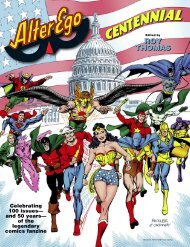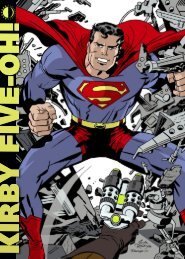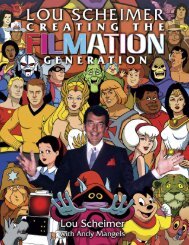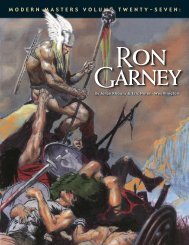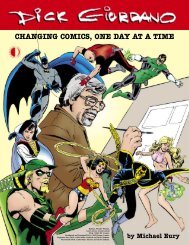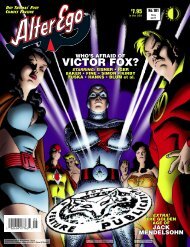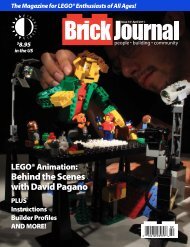Matt Baker: The Art of Glamour - TwoMorrows Publishing Store
Matt Baker: The Art of Glamour - TwoMorrows Publishing Store
Matt Baker: The Art of Glamour - TwoMorrows Publishing Store
You also want an ePaper? Increase the reach of your titles
YUMPU automatically turns print PDFs into web optimized ePapers that Google loves.
horn—they all had to move aside, and they were just freaked<br />
because I was driving this car. It was a brand new car, because<br />
that was a year when comic book sales were at their highest.<br />
<strong>Matt</strong> was doing quite well, so he was able to afford a brand<br />
new car.<br />
JA: According to Jerry Bails, <strong>Matt</strong> <strong>Baker</strong> seems to have<br />
started as an inker at Jerry Iger’s shop in 1942, but I think<br />
1944 is probably more accurate, partly because we know<br />
he signed his first story then.<br />
FR: That’s possible. I don’t know what year he left Washington<br />
and went to New York, but it’s quite possible that it was<br />
in the early ’40s. I don’t know who got him into comics; it<br />
might have been Jerry Iger. I remember that name.<br />
JA: I wonder what made him want to get into comics.<br />
FR: Probably money. I think he was working for one <strong>of</strong> the<br />
government agencies in D.C. Tons <strong>of</strong> blacks moved to Washington,<br />
because World War II created plenty <strong>of</strong> government<br />
jobs. That’s the reason that today there are more women in<br />
Washington than men: black women<br />
in Washington could get jobs, and<br />
didn’t have to work as domestics. If<br />
they knew how to type or file, they<br />
could get government jobs. <strong>The</strong>y were<br />
lower-echelon jobs, but at least they<br />
were able to work.<br />
JA: Do you have any idea if comic<br />
books were the first art jobs that<br />
<strong>Matt</strong> had?<br />
FR: My guess would be yes, because I<br />
can’t think <strong>of</strong> any other commercial art<br />
that he would have gone into. It definitely<br />
wasn’t advertising—like I did—<br />
and it wasn’t illustrating for magazines<br />
or other art directors, because that didn’t<br />
happen until the late stages <strong>of</strong> his career,<br />
which wasn’t a particularly good time<br />
for him. My guess would be that the<br />
comic books needed guys who could<br />
draw quickly, because they were literally<br />
cranking them out. I can remember that<br />
even during the year that I lived with<br />
him, comics were on the decline, but he<br />
would still get three or four stories at a<br />
time to draw. I’m sure that he got even<br />
more comics work back in the ’40s,<br />
probably as much as he had time to do.<br />
He was able to turn the things out so<br />
fast that he was in big demand.<br />
Page 4 <strong>of</strong> “Tugboat Tessie” from Seven Seas Comics #1 (April 1946). Scanned from the<br />
original art courtesy <strong>of</strong> Jeff Singh.<br />
JA: Where did <strong>Matt</strong> go to school?<br />
FR: He went to the Cooper Union<br />
School <strong>of</strong> Engineering, <strong>Art</strong>, and Design<br />
in New York City. I graduated from there<br />
too. <strong>Matt</strong> went there for a short time, and<br />
so did John. I don’t know what years they<br />
went there, or for how long, but I don’t<br />
think it was very long. I don’t think it was<br />
prior to World War II, because they were<br />
living in Washington, and they wouldn’t<br />
have known about Cooper Union until<br />
they moved to New York.<br />
100<br />
PART TWO


